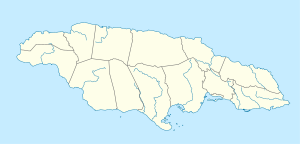Vernam Field
| Vernam Field Vernam Air Force Base |
|
|---|---|
| Part of Sixth Air Force | |
| Located in Clarendon Parish, Jamaica | |
|
Location of Vernam AFB, Jamaica
|
|
| Coordinates | 17°53′26.75″N 077°18′07.68″W / 17.8907639°N 77.3021333°WCoordinates: 17°53′26.75″N 077°18′07.68″W / 17.8907639°N 77.3021333°W |
| Type | Military airfield |
| Site information | |
| Controlled by |
United States Army Air Forces United States Air Force |
| Site history | |
| Built | 1941 |
| In use | 1941-1949 |
Vernam Field (locally spelled Vernamfield) is a former World War II United States Army Air Forces airfield located in Clarendon Parish, 34.3 miles (55.2 km) west-southwest of Kingston, Jamaica. The airfield was renamed Vernam Air Force Base by the newly formed United States Air Force in 1948, but was closed in 1949.
The base was named in honor of First Lieutenant Remington de Bremont Vernam (March 24, 1896 - December 1, 1918) an American pilot who entered the French air service during World War I. Vernam was shot down behind German lines on October 30, 1918. After the Armistice he was found by American forces in a hospital in Longwey, France, with another wounded aviator, Lt. Arthur C. Dineen. Vernam died of his wounds on December 1. He is buried in the American cemetery at St. Mihiel in Thiaucourt, France and was posthumously awarded the Distinguished Service Cross (United States).
The airfield has its origin in the 1940 Destroyers for Bases Agreement between Great Britain and the United States. For material support in the allied war effort, Britain agreed to lease as potential naval and air bases to the United States at several locations in the Americas.
The development of Vernam Field was viewed initially by the Army Air Corps as a staging field for training and for the operations of Borinquen Field, Puerto Rico. It was given its designation on 14 June 1941, and a force of 200 officers and enlisted men (known as "Force Tuna") embarked from New York and arrived on 17 November as a survey party to establish the airfield.
The design of the airfield was upgraded to that of a bomber airfield, and consisted of three runways: a 6000-foot concrete runway and two shorter asphalt runways to accommodate crosswind landings. When officially activated on 21 November 1941, the station was assigned to the 24th Composite Wing, Sixth Air Force, which controlled (in addition to this base) Atkinson, Beane, Coolidge, Ramey and Waller Fields in the Antilles Air Command. Constructions of airfield runways and a support station was ongoing throughout 1942, and the first operational unit did not arrive until September.
...
Wikipedia


